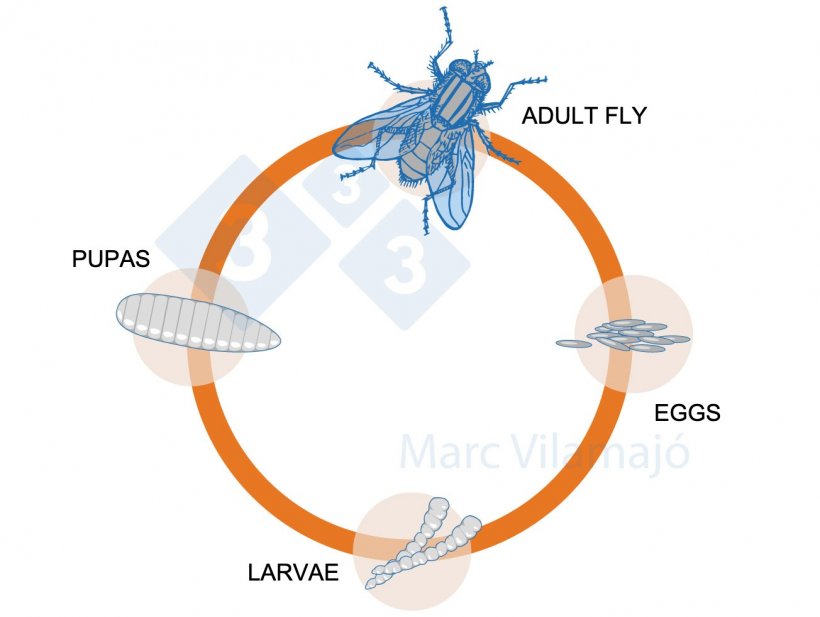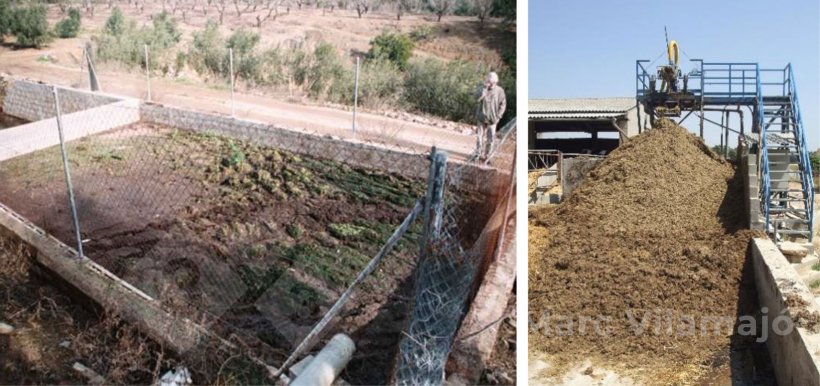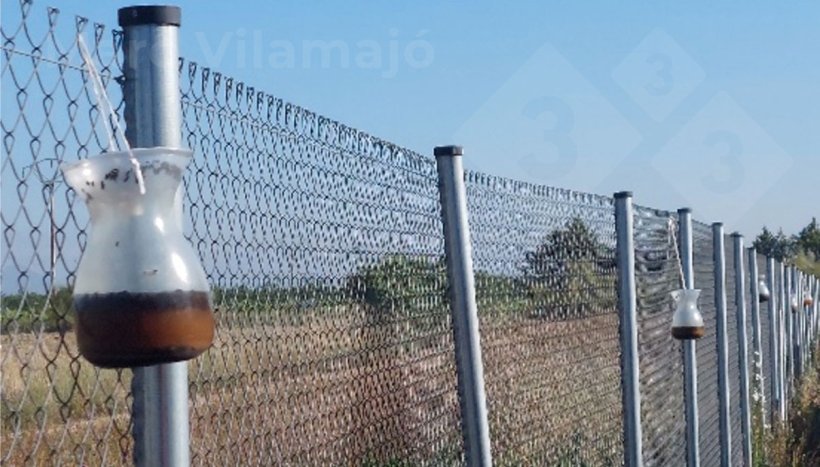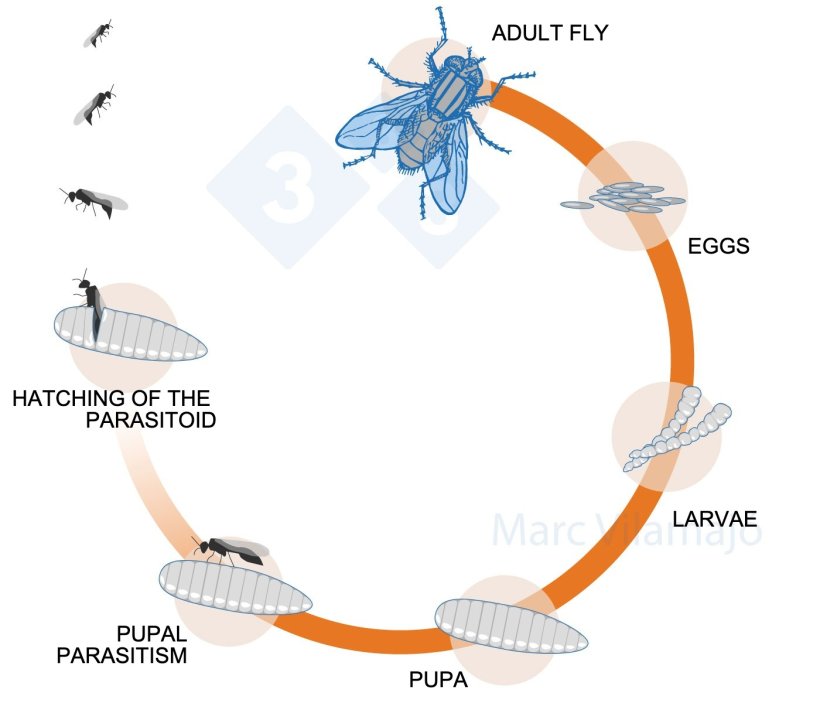Insects are often a nuisance that can become a plague. There are many species of flies, each with its own particularities and behavior, but they have common characteristics such as the type of reproductive cycle.
The adults found flying represent only about 1% of the population and are responsible for the reproductive phase. They mate and lay anywhere from a few dozen to a few thousand eggs on surfaces rich in organic matter with high humidity. Under favorable conditions, the eggs hatch and produce larvae (more than 50% of the population) that feed on this substrate and undergo various larval stages. Once mature, the larvae will pupate, i.e. become a pupa (about 30% of the population), which, through metamorphosis, will become a new adult fly. The duration of this whole process varies. A house fly, under favorable conditions, can complete this cycle in just one week, i.e. a fly can multiply by a few hundred in a single week, a few thousand in 15 days, and become a real problem before we even realize it.


Figure 1. Life cycle of the fly.
In which areas does most of this cycle take place?
In places with abundant organic matter and high humidity, such as manure piles, slurry pits and ponds, corners of stabling areas, or carcass containers. Pits and ponds with crust and solid materials will be the most critical points because when the material is more liquid it is harder for the larvae to grow and to pupate.

Photo 1. Pits and manure piles are critical points in fly control.
Why do flies pose a risk?
The pilose body of adult flies facilitates the adhesion of many microorganisms they carry from one place to another, increasing the risk of pathogen contamination on the surfaces where they land.
In most cases, they have a mouthpart shaped like a proboscis which first secretes saliva that dissolves the organic matter used as food and then licks it up. In species that feed on blood, the secreted saliva contains an anticoagulant factor that ensures greater blood flow, and therefore more food.
Their food sources usually have characteristics that facilitate the proliferation of microorganisms, which makes their role as vectors of infectious or parasitic diseases very significant.
Diseases that can be transmitted by flies include dysentery, salmonellosis, typhoid fever, myiasis, neonatal diarrhea, parasitosis, and intestinal amebiasis. In some diseases, flies act as hosts, playing a role in the pathogen cycle and its transmission, and in others their action as vectors is mechanical, acting as mere transporters.
In many cases, human activity provides unbeatable conditions for these insects to favor their development potential.
What fly control tools are there?
Physical control of adult flies:
- Multi-catch traps: traps with water mixed with a protein-based bait, which attracts and captures flies. Very effective for outdoor use to create perimeter barriers.

Photo 2: Multi-catch traps for adult flies located on the perimeter fence.
- UV light traps, which attract insects. They will be effective in poorly lit areas and at night and twilight hours. They can be:
- Bug zappers by electrocution
- Insect catchers (with adhesive film that captures flying insects)
- Sticky traps: adhesive strips, threads, tapes, etc., holders coated with an adhesive material that capture flies when they land on them.
Chemical controls:
- Larvicides: They are usually growth inhibitors that affect the larvae. They are applied on substrates where flies lay their eggs and larvae develop.
- Adulticide insecticides: to eliminate adults. They can be presented as:
- Granules made of some type of sugar treated with insecticide and attractant pheromones that are ingested by flies.
- "Paint-on" products made of some type of sugar treated with an insecticide and attractant pheromones. Flies are affected by ingestion or contact.
- Emulsifiable or ready-to-use insecticides, applied by spraying, atomization, fogging, etc.
Biologic control by using natural repellents made from plant extracts.
Control via pteromalidae, which are parasites exclusively to the fly pupa. The females lay their eggs in the fly pupa and their larvae feed on the fly undergoing metamorphosis. The result is that a new parasite is born instead of a fly, so we establish a population of parasites that will control the fly populations. These parasites will only focus their attention on the breeding sites of the flies; we will never find them on food, animals, or people.


Figure 3. Life cycle of the fly interrupted by a parasitoid.
What is the solution?
The solution is what is known as integrated control, which involves the combined use of several tools. We will begin by detecting the source of the problem, which involves determining the breeding points or where the flies are entering. Once the breeding point has been identified:
- We should evaluate implementing a physical measure, whether it be cleaning or correcting a structural element that will facilitate the elimination of the critical point, minimizing its effect.
- Or carry out a control strategy using larvicides, parasites, or both at different points.
Once this point has been addressed, the remainder of the treatment will be preventive or remedial.
As a preventive measure we can use traps outside to create a security perimeter to try to capture as many organisms as possible that try to enter, and we can also achieve some protection by using repellents at identified access points.
Remedial measures to eliminate the organisms we already have within the protection zone range from the continuous use of UV light devices to the use of insecticides where we detect the presence of adults. If a biological control strategy is being carried out, it will be necessary to minimize the use of insecticides and to use them far from the parasitoid application points.



